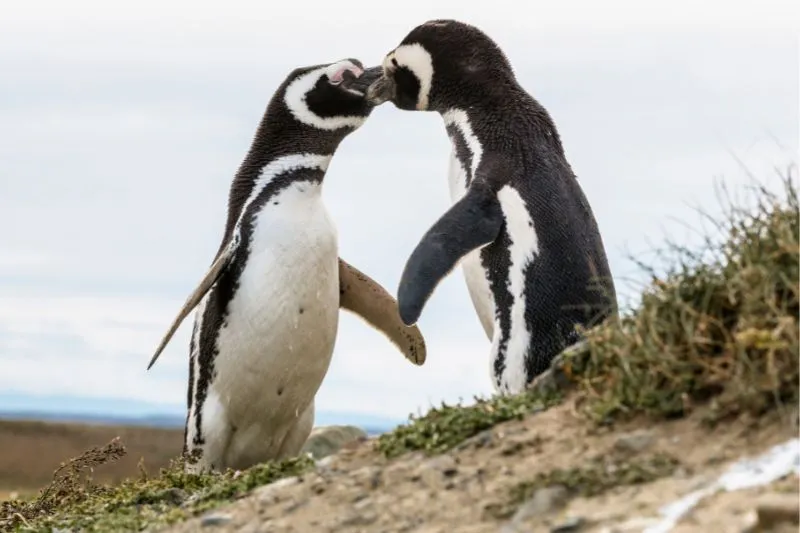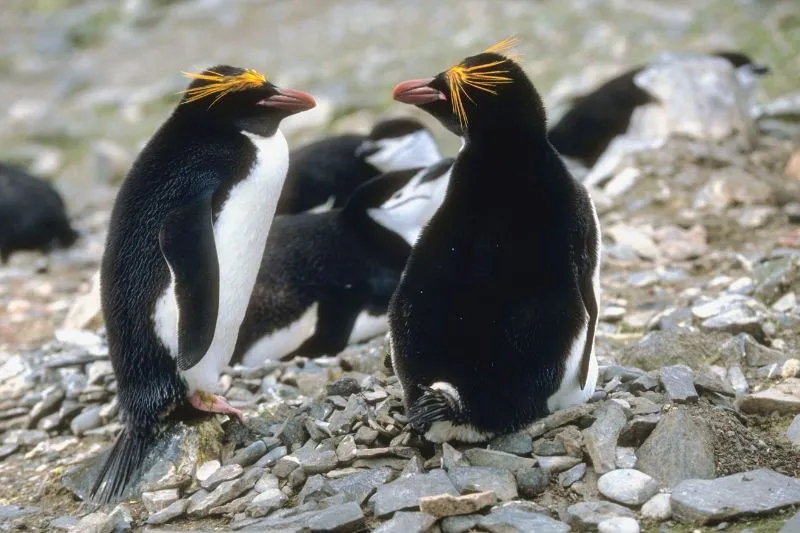The features of a penguin can vary widely depending upon the species, from its size to where it lives. So, how many penguin species actually are there?
According to the ITIS, there are 19 species of penguin still in existence today. They live across the southern hemisphere with only 5 types of penguins permanently living in Antarctica. Some organisations, such as the IUCN, don’t list the Eastern Rockhopper as a separate species and may therefore only note 18 species.
Keep reading for a full list of the different penguin species along with what makes each one unique.
How Many Species of Penguin Are There?
According to the Integrated Taxonomic Information System (ITIS) which is a global database of animal species, there are 19 species of penguin and 8 sub-species.
Here are the different types of penguins:
- Emperor Penguin (Aptenodytes forsteri)
- Royal Penguin (Eudyptes schlegeli)
- Adelie Penguin (Pygoscelis adeliae)
- Magellanic Penguin (Spheniscus magellanicus)
- Humboldt Penguin (Spheniscus humboldti)
- Southern Rockhopper Penguin (Eudyptes chrysocome)
- Fiordland Penguin (Eudyptes pachyrhynchus)
- Yellow-eyed Penguin (Megadyptes antipodes)
- Snares Penguin (Eudyptes robustus)
- Macaroni Penguin (Eudyptes chrysolophus)
- Galapagos Penguin (Spheniscus mendiculus)
- Erect-crested Penguin (Eudyptes sclateri)
- African Penguin (Spheniscus demersus)
- Chinstrap Penguin (Pygoscelis antarcticus)
- King Penguin (Aptenodytes patagonicus)
- Gentoo Penguin (Pygoscelis papua)
- Little Penguin (Eudyptula minor)
- Northern Rockhopper Penguin (Eudyptes moseleyi)
- Eastern Rockhopper Penguin (Eudyptes filholi)
Source: ITIS
Some organisations recognise different species so the result isn’t always the same. For example, the IUCN doesn’t recognise the Eastern Rockhopper so they only list 18 species.
How Many Families of Penguins Are There?
All of the penguin species can be grouped into six families of penguins, these are Aptenodytes (great penguins), Eudyptes (crested penguins), Eudyptula (little penguins), Megadyptes (yellow-eyed penguins), Pygoscelis (brush-tailed penguins), and Spheniscus (banded penguins).
How Many Penguin Species Live in Antarctica?
Only two species of penguins live permanently in Antarctica, these are Emperor and Adélie penguins. However, Chinstrap, Gentoo and Macaroni penguins can also be found breeding on the Antarctic peninsular taking the total number of Antarctic penguins to five. T
Between all five species, it’s estimated that there are 5.77 million breeding pairs of penguins in Antarctica across 698 nesting sites1 (source: Oceanites State of Antarctic Penguins Report).
See our dedicated guide to where penguins live for a map of their geographic range across the world.
19 Types of Penguins (+ Unique Facts About Each)
Below you’ll find images of each type of penguin along with a short description of what makes each unique. You can click through to find out more about each penguin type or check out our general penguin facts for a broader understanding of penguins.
1. Emperor Penguin

Emperor Penguins are probably what you typically think of when you imagine a penguin. They are the tallest penguins with an average height of 115cm (45 inches)2 (source: The Illustrated Encyclopedia of Birds: The Definitive Reference to Birds of the World, C. M. Perrins) and they live in Antarctica year-round.
2. Royal Penguin

Royal Penguins are the largest of the crested penguins standing at 76 cm (30″) tall. They have an orange beak and a crest of regal–looking yellow or orange feathers on their head.
They are endemic to Macquarie Island and nearby Bishop and Clerk Islands which all sit about halfway between Australia and New Zealand.
3. Adelie Penguin

Adelie Penguins are the other species that make Antarctica their true home, living there year-round. They are about average height for a penguin at 71 cm (28″) and you can identify them from the white ring around the eye on an otherwise totally black head.
4. Magellanic Penguin

The Magellanic Penguin can be found in South America on both the Atlantic (east) and Pacific (west) coasts.
They are similar in appearance to an African Penguin, however, it’s still easy to spot them thanks to a unique black band on their stomach and a white band on their head. Their 30-year lifespan makes them the longest-living penguins.
5. Humboldt Penguin

Humboldt Penguins live along the west coast of South America from Peru down to Chile. They are a member of the Spheniscus family, also known as banded penguins.
They have the usual black band on their front side like other banded penguins, but you can distinguish them due to a lot of black spots on their bellies and callous pink skin from the base of their beak up to their eyes.
6. Fiordland Penguin

Fiordland Penguins are found in New Zealand on the South Island as well as nearby islands including Solander Island, Codfish Island, and Stewart Island.
They are a member of the crested penguins and look near-identical to a Snares Penguin, except they don’t have a patch of bare skin around the base of their beak.
7. Yellow-Eyed Penguin

The Yellow-Eyed Penguin is endemic to New Zealand, living on the South Island, Stewart Island, and sometimes other nearby islands. It’s the only living member of its family, the Megadyptes Penguins.
They are easy to spot due to their yellow eyes and the yellow band of feathers that runs from one eye, over the top of their head, to the other eye (hence the name). It almost looks like they are wearing a yellow face mask like a burglar.
8. Snares Penguin

As you might have guessed from their name, Snares Penguins can be found on The Snares Islands, a small group of islands that lie around 200km south of New Zealand. It is a member of the crested penguins family, as noted from the yellow crest feathers just above its eyes.
They are almost identical to Fiordland penguins, although can be identified due to the patch of bare skin that runs around the base of their beak3 (source: New Zealand Government).
9. Macaroni Penguin

Macaroni Penguins breed in Chile, the Falkland Islands, the Antarctic Peninsula, and many sub-Antarctic islands.
Macaroni Penguins are a member of the crested penguins family with distinctive yellow feathers on their head and an orange beak.
10. Galapagos Penguin

The Galapagos Penguin is the most northerly of all the penguins, living in the Galapagos Islands, off the coast of Ecuador, which straddle the equator.
With only around 1,200 left in the wild, they are the smallest in terms of population size and are one of the penguin species classified as endangered by the IUCN.
11. Erect-Crested Penguin

Erect-Crested Penguins are mostly found on sub-antarctic islands to the southeast of New Zealand.
They have yellow crest feathers that are unique as they stick upwards like a hard brush and they have white or pale blue skin at the base of their beak.
12. African Penguin

The African Penguin is the only penguin that nests in, you guessed it, Africa. They are found along the southern coast of Namibia and South Africa. They are about average size for a penguin at 70 cm (27″) tall and can be distinguished due to a black stripe and black spots on their chest.
13. Chinstrap Penguin

Chinstrap penguins are the smallest of the bushy-tailed penguins, a family known for their long tails. They are easy to notice due to the black ‘Chinstrap’ which runs from ear to ear under their chin, making it look like they have a helmet on.
They live in Antarctica and on sub-Antarctic islands including the South Sandwich Islands, the South Orkneys, South Shetland and South Georgia, Bouvet Island and the Balleny Islands.
14. King Penguin

As the second member of the great penguins family, King Penguins are closely related to Emperor Penguins, only slightly smaller in size at 95 cm (37″) tall (see our penguin size guide here).
You can spot King Penguins because they have orange patches in the feathers on the side of their heads and on their chest. They also have orange patches on their beaks.
They breed on sub-antarctic islands with the largest populations found at South Georgia, Crozet Island, and Kerguelen Island.
15. Gentoo Penguin

Gentoo penguins are considered to be Antarctic penguins as they can sometimes be found on the Antarctic peninsular. They can also be found across sub-antarctic islands with the largest populations on the Falkland Islands and South Georgia.
Standing at 81 cm (32″) tall, they are the third largest penguin and can be spotted due to their red-orange beak and the white patch which extends from their eyes over the top of their heads.
16. Little Penguin

Little Penguins are the smallest species of penguin with an average height of just 40 cm (16″) to the tip of their beak4 (source: The Illustrated Encyclopedia of Birds: The Definitive Reference to Birds of the World, C. M. Perrins). They are also known as ‘Little Blue Penguins’ for their slightly blue appearance and they live in warmer climates of Australia and New Zealand.
17. Rockhopper Penguins

Depending upon who you ask, Rockhopper penguins might be classified as one species or split into two or three. For example, the IUCN recognises both Northern and Southern Rockhoppers as separate species, whereas ITIS also recognises a third species, the Easter Rockhopper.
Here is a breakdown of each of the three types of rockhopper penguin:
- 17. Northern Rockhopper Penguin – Compared to other rockhoppers, northern rockhoppers are larger and have longer crest feathers. They live in across 7 islands in the South Atlantic and Indian oceans between 37°S and 40°S.
ㅤ - 18. Southern Rockhopper Penguin – Southern rockhoppers are smaller than their northern counterparts. They tend to breed on sub-Antarctic islands in the South Atlantic, Indian, and Pacific Oceans between 46°S and 54°S, most notably Heard Island and the McDonald Islands and Macquarie Island.
ㅤ - 19. Eastern Rockhopper Penguin – The Eastern Rockhopper is sometimes treated as a separate species or sometimes as a sub-species of southern Rockhoppers so they share many of the same characteristics but has unique pink skin around the edge of its beak. The Eastern Rockhopper can be found in the Southern Indian and Pacific Oceans.


![You are currently viewing 19 Types of Penguins [+ What Makes Each Unique]](https://polarguidebook.com/wp-content/uploads/2022/12/Types-of-Penguins.jpg)


